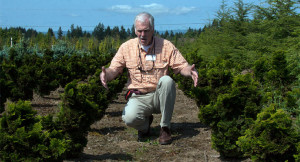
Where rows are wide enough to mow, WSU horticulturist Charles Brun recommends planting cover crops such as sorghum sudangrass or millet. Photo by Peter Szymczak
Good dirt is a combination of site selection and sustainable production practices
Imagine a wet, muddy, bare field just before spring planting. The soils are jam-packed with heavy, thick clay. Stormwater runoff over sloped areas has eroded the ground. Invasive weeds such as horsetail and Canadian thistle have secured footholds over the long winter.
Now, imagine this field is part of your nursery. You need to restore this field to good health and prepare the soil for crop production. What do you do?
Soil health is one of the most fundamental elements in nursery field production, and sometimes taken for granted. Yet paying attention to soil health will increase the sustainable lifetime of a farm, said Scott Eden, resource conservationist with the Marion Soil and Water Conservation District.
“If soil is being used faster than it is created, eventually you lose the productive, fertile soils and get down to mineral soils, or your rooting depth decreases,” Eden said. “And to grow the crop it will take more inputs, eventually becoming unprofitable. It takes 100 to 250 years to create an inch of topsoil. This means you are still losing topsoil, albeit very slowly.”
A clay-rich field is not necessarily bad, explained Don Richards, president of Applied Horticultural Consulting Inc. However, one must take the type of production into consideration.
“To maintain healthy soils for field nursery production, the right soil type must be chosen to begin with,” Richards said. “Heavy clay soils are typically not well suited to most field production, with the exception of crops where soil balls are harvested with the plant. In this case, some clay content in the soil helps to hold the soil ball together.”
The keys to healthy soil
To start off right in building healthy soil, Richards invoked the old adage — “Location, location, location.”
“Making a good choice of growing sites is critical for a field operation to provide the ability to manipulate the soil to benefit the specific crop,” Richards said.
The importance of site selection was emphasized as well by Dr. Ted Bilderback, former director of the JC Raulston Arboretum at North Carolina State University. To assess soil health, one must examine the site’s soil type, texture, drainage, erosion potential and soil fertility, Bilderback said.
Beyond choosing the right location, there are other ways to build soil health.
“Tilth management, or soil structure management, is another area of concern for field production,” Richards said. “Aeration of the soil must be possible to maintain tilth, and is usually accomplished prior to planting using heavy equipment to rip open the soil to planting depth and loosen its structure.”
Richards said planting cover crops helps stabilize the soil, and is also a good way to add organic matter to it.
Cover crops were also recommended by Dr. Charles Brun, a horticulture advisor with the Washington State University Extension Service in Vancouver, Washington, who has expertise in nursery field production, as well as Christmas tree and greenhouse production.
“Perennial cover crops would work especially well to keep runoff from leaving a nursery,” Brun said. “Perennial ryegrass is the most appropriate for in-ground B&B tree growers. Probably the best examples of perennial ryegrass used this way are at JB Instant Lawn and Nursery in Salem and Kinen’s Big and Phat Special Plants in Gresham.”
Without cover cropping or soil amendments, repeatedly plowing and then turning over a field with a disc harrow has its drawbacks, Brun said. That powerful machine may be the most efficient way to rip through soil clumps and tear out old crops, but use it too much without improving the soil and you risk increasing the density of the soil, taking away “breathing space” for plant roots.
“Larger tree growers should invest in a permanent cover crop such as dwarf ryegrass,” Brun said. He also recommended summer cover crops that could be planted in between the aisles of nursery rows. Sorghum sudangrass, pearl millet, German foxtail millet and browntop millet are good choices if it’s possible to mow between rows.
“It’s probably a better idea to use annual cover crops because they build the soil texture and tilth, and make a difference in how well soil works,” Brun said.
Additional measures
In combination with a cover crop, Brun recommended a catchment basin and riparian buffer strips to reduce erosion and trap runoff. Maintaining grassy buffer strips is especially important for swale areas, rather than simply leaving them as muddy ditches.
Eden said the most important way to build organic matter in the soil is to keep vegetation on the soil in the winter.
“Soil becomes depleted of organic matter when it is cultivated repeatedly,” Eden said. “This can be slowed by conservation tillage techniques, adding mulch or compost, keeping a cover crop, or by rotating crops. Cover crops can be tilled in as green manure, adding more organic content. Higher organic matter means the soil structure is better, and the soil can hold more water and carbon. Irrigation events can be delayed or reduced, further improving soil health, and keeping any nutrient inputs from leaching through the soil profile or running off the surface.”
Once again, imagine the muddy, clay-rich field. Now imagine that same field planted with the lush green stalks of perennial ryegrass and maintained with good production practices such as crop rotation.
The benefits to the soil are significant. It now crumbles more easily, with fewer weeds. More earthworms thrive in this looser soil. It may not ever be perfect soil, but it will be better with a combination of sustainable production practices.


